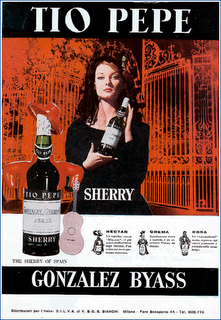Fino and Manzanilla...must drink more of it
It's quite rich textured, with some appley, nutty (acetaldehyde) notes countering the bracing, almost salty freshness. It's 15% alcohol, which isn't much more than many table wines, but it does give some warmth and texture to the otherwise super-fresh palate. I don't know if I could serve this at a dinner party with non-wine geeks, but I do wonder why more people don't use Fino or Manzanilla at table more, especially when you get a really interesting wine for £8 (Sainsbury's, Tesco, Waitrose, Whole Foods).
I'm comparing it with another similarly styled wine, M. Fina from Gonzalez Palacios. It's from Lebrija, a town located between Jerez and Sevilla, an it's made with flor like Fino and Manzanilla. It's nuttier and perhaps saltier than the La Gitana, with a bit more depth, but less of the zingy freshness. It has lots of that nutty, appley acetaldehyde character, and is highly food compatible. Yours for £6.95/half from Warren Edwardes' new venture www.stickywines.co.uk. Whether you prefer this or the more edgy La Gitana is probably a matter of taste. Warren sent this interesting nugget about Lebrija:
'Grapes from Lebrija are permitted to be used to produce Sherry and Manzanilla in Jerez and Sanlucar in the DO Jerez-Manzanilla. But vinification of the grapes in Lebrija is not permited to be designated as DO Jerez-Manzanilla. So Bodegas Gonzalez Palacios have demonstarted the quality of their wines to the Andalucian Government and have finally secured their own Quality Region with a view to moving on to a single estate Pago. Arguably Lebrija is more suitable than coastal Sanlucar de Barrameda for the production of "Manzanilla". The hill-top location of the Gonzalez Palacios bodega outside Lebrija along with its coastal aspect ensures a lower temperature not only than Jerez but also Sanlucar de Barrameda so comfortably ensuring a year round flor cover that leads to the sea-salty taste remniscent of "Manzanilla" - only more so. But DO Manzanilla ensured through the courts that wines produced by Gonzalez Palacios in Lebrija cannot be called "Manzanilla Fina". Hence M. Fina or Flor de Lebrija.'
Labels: fino, manzanilla, sherry, spain

 The web log of wine journalist Jamie Goode. Feel free to nose around; your comments are welcome
The web log of wine journalist Jamie Goode. Feel free to nose around; your comments are welcome 
